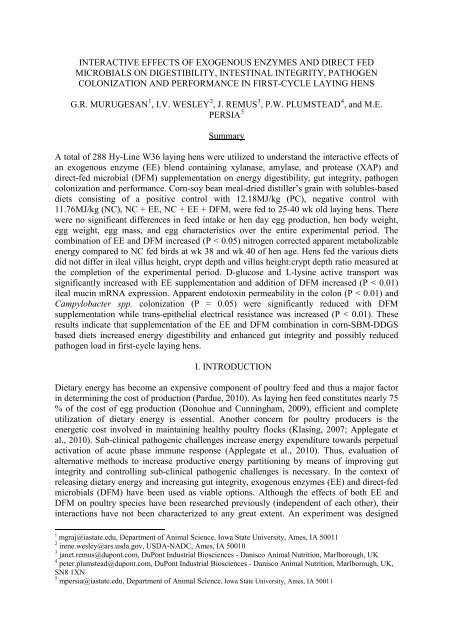APSS 2013 Proceedings - The University of Sydney
APSS 2013 Proceedings - The University of Sydney
APSS 2013 Proceedings - The University of Sydney
You also want an ePaper? Increase the reach of your titles
YUMPU automatically turns print PDFs into web optimized ePapers that Google loves.
INTERACTIVE EFFECTS OF EXOGENOUS ENZYMES AND DIRECT FED<br />
MICROBIALS ON DIGESTIBILITY, INTESTINAL INTEGRITY, PATHOGEN<br />
COLONIZATION AND PERFORMANCE IN FIRST-CYCLE LAYING HENS<br />
G.R. MURUGESAN 1 , I.V. WESLEY 2 , J. REMUS 3 , P.W. PLUMSTEAD 4 , and M.E.<br />
PERSIA 5<br />
Summary<br />
A total <strong>of</strong> 288 Hy-Line W36 laying hens were utilized to understand the interactive effects <strong>of</strong><br />
an exogenous enzyme (EE) blend containing xylanase, amylase, and protease (XAP) and<br />
direct-fed microbial (DFM) supplementation on energy digestibility, gut integrity, pathogen<br />
colonization and performance. Corn-soy bean meal-dried distiller’s grain with solubles-based<br />
diets consisting <strong>of</strong> a positive control with 12.18MJ/kg (PC), negative control with<br />
11.76MJ/kg (NC), NC + EE, NC + EE + DFM, were fed to 25-40 wk old laying hens. <strong>The</strong>re<br />
were no significant differences in feed intake or hen day egg production, hen body weight,<br />
egg weight, egg mass, and egg characteristics over the entire experimental period. <strong>The</strong><br />
combination <strong>of</strong> EE and DFM increased (P < 0.05) nitrogen corrected apparent metabolizable<br />
energy compared to NC fed birds at wk 38 and wk 40 <strong>of</strong> hen age. Hens fed the various diets<br />
did not differ in ileal villus height, crypt depth and villus height:crypt depth ratio measured at<br />
the completion <strong>of</strong> the experimental period. D-glucose and L-lysine active transport was<br />
significantly increased with EE supplementation and addition <strong>of</strong> DFM increased (P < 0.01)<br />
ileal mucin mRNA expression. Apparent endotoxin permeability in the colon (P < 0.01) and<br />
Campylobacter spp. colonization (P = 0.05) were significantly reduced with DFM<br />
supplementation while trans-epithelial electrical resistance was increased (P < 0.01). <strong>The</strong>se<br />
results indicate that supplementation <strong>of</strong> the EE and DFM combination in corn-SBM-DDGS<br />
based diets increased energy digestibility and enhanced gut integrity and possibly reduced<br />
pathogen load in first-cycle laying hens.<br />
I. INTRODUCTION<br />
Dietary energy has become an expensive component <strong>of</strong> poultry feed and thus a major factor<br />
in determining the cost <strong>of</strong> production (Pardue, 2010). As laying hen feed constitutes nearly 75<br />
% <strong>of</strong> the cost <strong>of</strong> egg production (Donohue and Cunningham, 2009), efficient and complete<br />
utilization <strong>of</strong> dietary energy is essential. Another concern for poultry producers is the<br />
energetic cost involved in maintaining healthy poultry flocks (Klasing, 2007; Applegate et<br />
al., 2010). Sub-clinical pathogenic challenges increase energy expenditure towards perpetual<br />
activation <strong>of</strong> acute phase immune response (Applegate et al., 2010). Thus, evaluation <strong>of</strong><br />
alternative methods to increase productive energy partitioning by means <strong>of</strong> improving gut<br />
integrity and controlling sub-clinical pathogenic challenges is necessary. In the context <strong>of</strong><br />
releasing dietary energy and increasing gut integrity, exogenous enzymes (EE) and direct-fed<br />
microbials (DFM) have been used as viable options. Although the effects <strong>of</strong> both EE and<br />
DFM on poultry species have been researched previously (independent <strong>of</strong> each other), their<br />
interactions have not been characterized to any great extent. An experiment was designed<br />
1 mgraj@iastate.edu, Department <strong>of</strong> Animal Science, Iowa State <strong>University</strong>, Ames, IA 50011<br />
2 irene.wesley@ars.usda.gov, USDA-NADC, Ames, IA 50010<br />
3 janet.remus@dupont.com, DuPont Industrial Biosciences - Danisco Animal Nutrition, Marlborough, UK<br />
4 peter.plumstead@dupont.com, DuPont Industrial Biosciences - Danisco Animal Nutrition, Marlborough, UK,<br />
SN8 1XN<br />
5 mpersia@iastate.edu, Department <strong>of</strong> Animal Science, Iowa State <strong>University</strong>, Ames, IA 50011
















